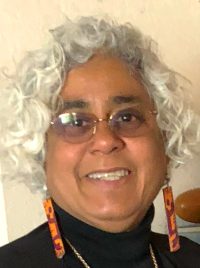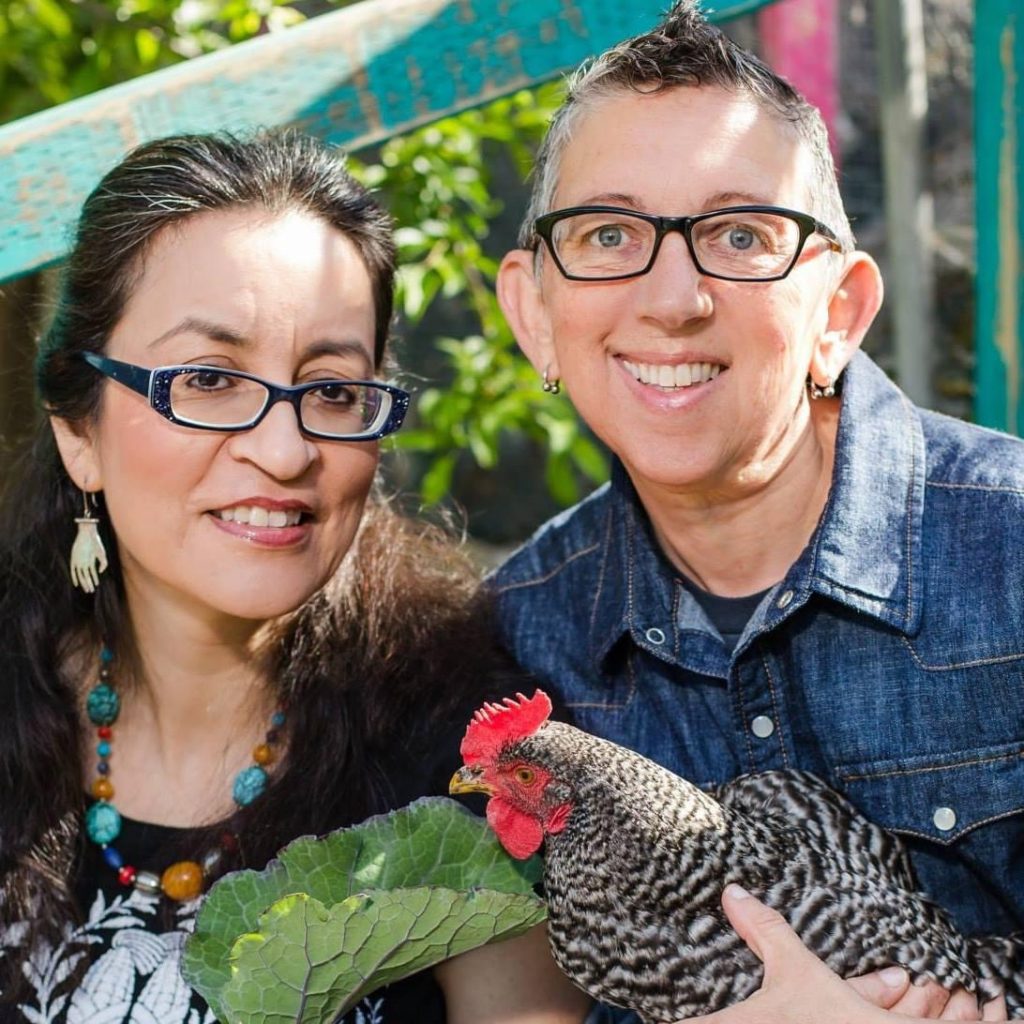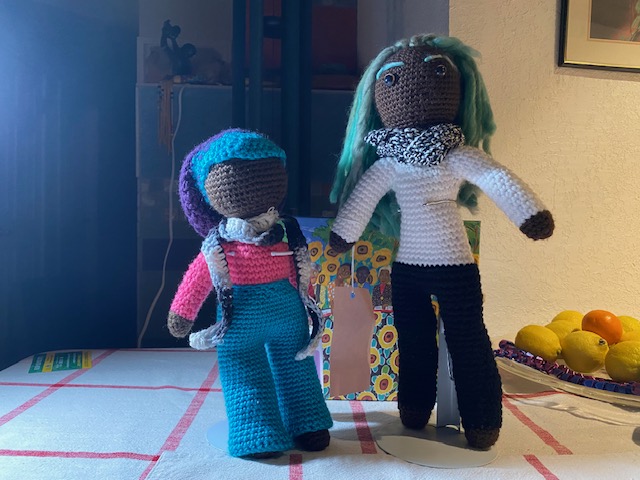Honoring Dr. Catrióna Rueda Esquibel / Muñeques Negres: To Find Ourselves
April 2024
When Catrióna invited me to co-write an article on Black dolls with her for Contours: ArteCalle Journal, I never imagined that I would be writing a piece to honor Catrióna, the ancestor. Her sudden transition rendered me silent, for words seem inadequate to express the enormity of the loss our community is facing. The void is infinite and the silence of her voice incites a painful melancholy. Trying to make sense of this loss, I turn to the epistemologies and pedagogies of the Puerto Rican tradition of Bomba. I begin with the maraca to call for the sacred rhythm of Yubá. This is the rhythm that translates the suffering of our ancestors, that we may experience healing and gain wisdom. The maraca calls in the drum, the buleador, and it is through the rhythm of Yubá that the words come. To honor Catrióna, I have created a tapestry of her words. In doing so, I discovered that she did not leave us alone in struggle; she provided us with a charge a while back. It was hidden in plain sight.
Catrióna will forever be our Queer Chicana Warrior, with a pen and crocheting needle in one hand and a machete in the other. In her position of Associate Dean in the College of Ethnic Studies, at San Francisco State, she defended, protected, and nurtured the faculty, staff, and students. Catrióna was the keeper of the temple in the sacred space where Ethnic Studies emerged as a movement and as an academic discipline to ensure that our stories – all of our stories— hold a place in the academy and in our communities. In times of turbulence and change in the College of Ethnic Studies, she stepped into leadership positions to ensure the continuity of each of the programs in Ethnic Studies. She recognized the sacredness of our social justice work and tended to its present and future by keeping the sacrifices of those who came before us in our consciousness.
As a scholar, Catrióna left us a blueprint of how to continue social justice work wherever we find ourselves. In the Prologue of her book, With A Machete in Her Hand, she embeds her charge to us. She states, “All stories start in the past memory, in the fantasy of what once was or will be or has been or is now… It all started with a story” (p. xiv). Whether in our kitchens, community spaces, our classrooms in the academy, or around a craft table, there is the exchange and preservation of our stories. These are the spaces where we learn our history and stories of resistance. All of Catrióna’s work involved the telling, preserving, critiquing—the story.
In the Prologue, she reminds us of the simple truth of humanity. She writes, “And some folks say she’s a butch, not into roles, or “classically lesbian.” I say she shows that desire is pocha. That what Chicana Lesbians want is to be loved, to be claimed, to go back to the beginning” (xv). The foundation of social justice work is grounded in the desire to be loved. This is not a sentimental love; this is a Chela Sandoval, bell hooks, Audre Lorde type of love, decolonized, committed, and grounded in action.
Catrióna was committed to talking back to those who disrespect us. One of my favorite pictures of her was taken this year, at the Port of Oakland. She is seen “talking back” to those taking weapons to Israel. She inspired us to use our voices to talk back to our oppressors. Her pedagogy was grounded in talking back.
“The authors I talk about, talk back. If they react defensively, its because they’re real women (and men) who have been disrespected, scapegoated, threatened, and vilified. Who began to write fearing their lives but who nevertheless continue to write, and to nurture young writers.” (xv)
The work we do in social justice spaces teach those that come after us to “talk back” to the interlocking systems of oppression, whether through writing, crafting, or marching.
Catrióna modeled for us that we are enough. We did not have to prove our worth to her; she valued and nurtured us. In Machete, she states, “I love being the critic because it gives me the opportunity to give their work the attention it deserves…I get to be the reader to whom the author doesn’t have to prove she is queer enough, chicana enough, lesbian enough, Mexican enough, feminist enough, (Enough is enough!)” (p. xv). No matter how much the forces and processes of colonization try to indoctrinate us with notions of scarcity and deficit, we are enough. Catrióna, lovingly reminds us that, indeed, we are enough. She states,
“My job is to link the stories with the clever remarks, to teach the significance of the work, whether in print or in the classroom. My job is to gather the lost stories and tell them to new generations of women and men who never knew what came before…My job is to remind old-school nationalist machistas that influence doesn’t flow in one direction, that queer Chicana art and fiction is important not only for what it says about queer Chicanas but also what it says about Chicano/a culture, about American society….” (xvi)
As Elders, teachers, leaders, community members, our job is to link the stories, to teach the stories to the new generations that come after us. So this is our charge.
Our Beloved Guerrera did not abandon us in the struggle. Her words and her dolls are here still, wrapped in the love she has for us, our stories, the struggle, and the cleareyed hope of victory.
Catrióna shared with me that she made dolls during the AIDS epidemic because there were many wonderful people dying, and she was determined their stories would not be forgotten. She made dolls of each of the people she knew. Each doll was the embodiment of the person’s story. She said one day she looked up, and all of her dolls were of dead people, so she decided to start making dolls of the living. She made sure that the stories of Black and Brown communities would be embodied in her dolls, her persyns. Not only does each doll embody a story, whether through her intentions, her love, or her hair getting entangled with the yarn, each doll carries a piece of Catrióna.
As in the times before, when a guerrera falls, the warriors she fought along side with step into the void, carrying the fallen guerrera, now ancestor, in our hearts and in our actions continuing to victory. What follows is Catrióna’s last essay. Let us as a community of Warriors, gather, to hear the message of our beloved Queer Chicana Warrior.
Editor’s note: On Feb 8, 2024 Catrióna Rueda Esquibel made her transition and became an ancestor. We were in the middle of editing her contribution to this edition. In her loving memory, we publish her piece.
Muñeques Negres: To Find Ourselves
By Catrióna Rueda Esquibel
I started with crocheting bears. It was for a program “for kids affected by AIDS,” and the kids were in Africa. Bears were my first crochet effort, apart from “flat” projects like afghans and scarves. I was really into it; I made something like 43 bears my first year. But the online group that supported this project, which featured all the bears that other folks were making, was dominated by “light skinned” bears. The orphanages requested more dark brown bears, but the makers continued to dontate more “blonde” bears. That is, Anglo-American crafters were making “blonde” bears rather than the brown bears that were requested. The discourse around the kids was also problematic. Understand that there are retirement homes that work on these bears and sometimes the people interviewed had lost some of their cognitive skills. In the discussion boards, the makers would repeat stories about child rape and say that the bears would help these traumatized children. The ways in which African people were fetishized and sexualized made me feel more and more that these were not my people and that this was not my project. To bring my sensibilities and commitments to the project, I created bears inspired by Taraji P. Henson and Mahershala Ali, by Borderland’s papier mache dolls, and by the practice of Mexica danza.
I went through a spell where I would create bears to memorialize trans people of color who were killed by hate crimes. When I transitioned from making bears to making non-binary dolls of color, I also produced a doll for Vanessa Guillén, who disappeared and was discovered murdered. I finally had to stop myself because I wanted my dolls to be associated with life, not with death. This is something I still struggle with – the impulse to memorialize but the need to not focus on death. Sometimes I want to offer healing to an ancestor who didn’t have all the freedoms I have to be out and queer, to pursue education, to live without children.
And then I more or less stumbled onto a community of African American crochet dollmakers. Aniqua Wilkerson of My Kinda Thing, Yolonda Jordan of My Pretty Brown Doll, Lisa Palmer-Davis of Knits and Hooks, and Tanya Powell of TLP Brown Sugar Babies. They were giving voice to a very clear issue of dollmaking, the dominance of white dolls [white supremacy] in the mainstream doll market, and the absence of Black voices.
Through Facebook groups, Instagram posts, Periscope videos, YouTube tutorials, these designers created larger communities, calling out Black and brown women into the world of doll-making. The designers created patterns for beginners, produced classes, taught us how to make dolls, that were not mere brown recreations of white dolls but drew from traditions of Black hair, Black style, and Black mothering. Mermaids that traced their ancestry to Mami Wata and the transatlantic slave trade, rather than to Hans Christian Anderson. This community was called into being by these dollmakers. They taught the skills you would need to make your own dolls.
“There is more to making a Black doll than brown yarn,” Aniqua Wilkerson says. Mind you, Wilkerson has produced two different lines of yarn: Lion Brand Skein Tones and My Kinda String. Both yarns have a range of skin tones in which Black beauty can be realized. In Wilkerson’s designs, she’s drawing from the culture of hairstyling and celebrating Black joy. She celebrates the beauty of Black folks from mermaids to Black Power activists, from Ice Cream gals to Cutie Pies. Together, but separately, Yolonda Jordan brings characters to life through her book My Pretty Brown Doll: Crochet Patterns for a Doll Who Looks Like You. The book contains patterns for a base doll, a fairy doll, a mermaid, a schoolgirl, an athlete, and a Paris doll. These can be Tea Party Dolls (dressed up or sitting on a shelf) or they can be the much loved doll that a child carries with them everywhere they go. The dollmakers cleverly give directions for clothes that look as if they are removable but really aren’t, because sometimes you want your kid to not carry a naked doll!
Most of these instructions were not free. The designers also focused on Black woman entrepreneurship and making a living from their art. They produce bespoke dolls at high price points because they value what they do. Yolonda Jordan (through her platform My Crochet Life) focuses on visualizing your own success and the work that is required to produce it.
When I first created a doll (made a round “human” head instead of a flat, bear’s head) I felt myself reacting very negatively, like I was doing brujería, making poppets. It wasn’t until I read Elena Avila’s Woman Who Glows in the Dark that I came to realize that dolls can be part of our healing practice. I re-read Clarissa Pinkola Estés, and found that we can each make our own spirit doll to represent those who have gone before us or our own childhood selves, and we can give them love and respect.
Most recently, I’ve read Mona Susan Power’s novel A Council of Dolls, in which Sissy, a Dakota girl, is given a Black doll by her father. She loves this doll, Ethel, and takes her everywhere with her. When white people react negatively to her doll, their racism becomes visible. Ethel becomes the barometer for knowing if the environment is safe.
The world of dolls is a space where we can view white aspiration. It’s a microcosm of our world where what is unsaid is played out. We are taught that white dolls are the most desirable of all. As a child, I think I had exactly one doll that was not blonde-haired and blue-eyed. What the African American dollmakers I have written about are asking is that we refuse the pigmentocracy, the hierarchy that puts white skin at the top and Black skin at the bottom. They teach us how to go beyond the blonde-haired, blue-eyed plastic figures to find ourselves, our histories, futures, and our fantasies.

Catriona Rueda Esquibel (Dec 20, 1965-Feb 8, 2024 ) holds a B.A. in English from New Mexico Highlands University (1988), a Master’s degree in English literature from the University of Colorado (1991), and a Ph.D. in the History of Consciousness Program at UC Santa Cruz (1999). Before joining the faculty at San Francisco State University in 2005, she held positions at New Mexico State University (English) and Ohio State University (Women's Studies). She joined the Race and Resistance Studies Department at SFSU as a specialist in gender, Women of Color feminist theory, and queer POC literature. In addition to her faculty positions, she served for many years as Associate Dean of the SFSU College of Ethnic Studies. Dr. Esquibel is best known for her books, With Her Machete in Her Hand: Reading Chicana Lesbians (U of Texas, 2006) and Decolonize Your Diet: Plant-based Mexican-American Recipes for Health and Healing (Arsenal Pulp 2015), co-authored with Luz Calvo.

Dr. Eileene Tejada has a doctorate in Anthropology and Social Change. She is an anthropological researcher and ethnographic writer committed to decolonizing knowledge. As an anthropologist, who is engaged in both scholarly and engaged in activism, Dr. Tejada writes about the history of Bomba, a form of cultural production, which is birthed by the Taíno-African alliance in resistance to the processes of colonization and slavery in Puerto Rico. Dr. Tejada is also a poet, who is writing a book about the impact of European colonization and the Trans-Atlantic Slave Trade in the historical development of the Taíno and African roots of her own Puerto Rican family. She grounds her analysis of cultural production under the regime of globalism in her knowledge of sociocultural and economic history. Dr. Tejada believes that the Bomba tradition provides the roadmap for the decolonization and the liberation of el pueblo Puertorriqueño. Dr. Tejada has taught English Composition, Literature, and Critical Thinking for 35 years, 30 of them at Napa Valley College. She has served in a variety of leadership positions in the NVC Academic Senate, including two terms as Academic Senate President. Her service and commitment to higher education is demonstrated by the wide range of leadership positions at the local and state level, including two terms as a commissioner for the Accrediting Commission for Community and Junior Colleges. As a union organizer and officer, she negotiated faculty contracts. She served as Vice-President of the Napa Valley College Faculty Association. She is currently a lecturer in the College of Ethnic Studies at San Francisco State University. She raised two daughters, while working as a disciplined academician, who passionately is committed to the promise of educational access and supports higher education for all.





